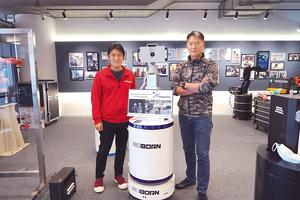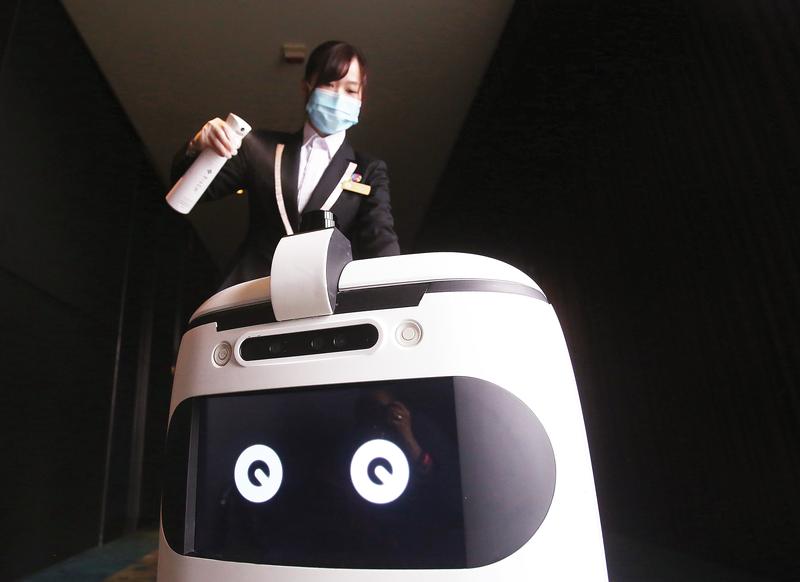Robots developed in Hong Kong have joined the battle against the COVID-19 pandemic. With so much commercial activity shutdown, local science and technology companies see big opportunities. Kathy Zhang reports.
 Larry Poon Ka-yeung (right), co-founder and chief executive officer of Roborn Technology, and Mark Mak Hin-yu, stand beside the temperature measurement robot PEP3000. (NORA ZHENG / CHINA DAILY)
Larry Poon Ka-yeung (right), co-founder and chief executive officer of Roborn Technology, and Mark Mak Hin-yu, stand beside the temperature measurement robot PEP3000. (NORA ZHENG / CHINA DAILY)
No need for protective gear, this frontline worker screening out potential coronavirus patients at a government office is a robot.
The robot, named PEP3000, uses artificial intelligence to support teams of human workers assigned to do everything they can to contain the spread of the disease.
PEP3000 was on duty when civil servants at the Electrical and Mechanical Services Department in Kowloon Bay returned to work in early March. The eagle-eyed robot, waiting at the entrance, checked everyone coming in during the high traffic periods every day. Anyone running a temperature is swiftly sorted out.
Genie removes much unnecessary contact between hotel guests and staff, and that helps lower the risks of cross-infection during the coronavirus pandemic
Victor Lee, founder and chief executive officer of Rice Robotics
During off-peak hours, the robot patrols areas inside the building, leaving nothing to chance.
These robotic assistants are standing watch at some of the city’s cultural and sports centers, medical establishments and government buildings.
It can spot a fever up to eight meters away, checking out multiple passersby on a single pass. PEP3000 uses a thermal imaging camera for detecting people who are feverish. Another camera is set up for facial recognition. The camera is also able to capture the images of targets around them and then upload the data to cloud storage.
Once PEP3000 spots someone whose temperature is above the threshold set by management, it will set off an alarm.
Meanwhile, the human worker in charge of monitoring the robot’s operations receives the alert through a mobile device connected with the robot’s software system.
The human monitor also sees photographs of people “apprehended” by the robot through the mobile unit, and then he/she can direct his/her colleagues to find the target for further examination.
If the target is proven to be infected with the novel coronavirus pneumonia, the image data will assist to identify those had close contact with the patient.
Clients can set their own parameters, like whether the image data will be saved and how long the data can be saved, in accordance with their own privacy policies.
The robot was developed by Roborn Technology. Mark Mak Hin-yu, co-founder of the locally-based company, said AI helps the robot recognize the human forehead. “It reduces the chance to give false alarms.”
Without the recognition technology, the alarm would be triggered by a sip of hot coffee, or those just opening their mouths, he explained.
False alarms would strain frontline workers who follow up every alarm.
The cameras are adjusted to different heights, to reduce the possibility of running into dead spots.
“In addition to adults walking upright, kids, wheelchair users or those sitting in a canteen can be detected easily by the robots,” said Mak.
A race with contagion
It took only 15 days for the Hong Kong-based research and development team to complete the design and assembly of the smart robot.
Larry Poon Ka-yeung, co-founder and chief executive officer of Roborn, saw the opening for a smart robot during the earliest stages, when the COVID-19 pandemic started in January and before Hong Kong had tightened local screening and containment.
The first thought was for frontline workers, who are at high risk of infection because their jobs made them responsible for dealing with hundreds or thousands of people who might be carriers. Security guards stand at entrances with manual, infrared temperature guns, and check, at close quarters, every person coming in. “But robots can replace them to do this risky job, effectively easing their burden amid the pandemic,” said Poon.
A team of about 10 company employees went to work on Jan 25, abandoning their Chinese New Year plans. Their aim was to devise an effective tool for protecting front-line workers, Poon recalled.
“After the race kicked off, members of the team slept an average of only four hours a day,” he said.
The two weeks of relative sleep deprivation paid off. The robot was approved for a test run at the entrances to government buildings by mid-February.
By late March, about 20 of the robots were deployed at several buildings across Hong Kong. Poon says the company already is working to fill orders for 50 more devices.
Crisis means opportunities for local sci-tech companies.
One Hong Kong hotel uses a robotic approach to keeping watch on social distancing guidelines, while the outbreak lasts.
Since the beginning of March, L’hotel Island South in Wong Chuk Hang, Hong Kong Island, has hired a special helper for its hospitality staff. Appropriately named Genie, the hotel describes it as an AI-based robot with full immunity to the dreaded virus, or any virus, for that matter.
 A hotel staffer disinfects the robot Genie after it completes a delivery. (PARKER ZHENG / CHINA DAILY)
A hotel staffer disinfects the robot Genie after it completes a delivery. (PARKER ZHENG / CHINA DAILY)
Genie does some of the riskiest assignments, like making deliveries of food or other stuff guests need to their rooms.
The hotel has guests in quarantine. The Hong Kong government requires all arrivals from overseas and the Chinese mainland to undergo a 14-day quarantine at their living places. Some people choose to book a hotel to avoid close contact with their families during the quarantine.
What’s more, Genie is quite a capable worker, according to Catherine Yuen, senior marketing communications manager of L’hotel Management Company. Each time, the robot can deliver up to two meal sets and eight beverages to guests.
Engineers map the hotel into the robot’s memory. A staff member keys in the guest’s room number to Genie’s control panel and puts the food and drinks in the container. Then, Genie sallies forth. It navigates around the hotel along designated routes and stop in front of the pre-assigned room waiting for the guest to retrieve the deliveries after inputting a correct password. After the guest closes the cover of the container, the delivery is completed.
When Genie’s software system is connected with the elevators’ control system, it can use the elevators to serve guests on different floors. Genie sends instructions to control the elevator via connected systems.
Genie was also designed and developed in Hong Kong by Rice Robotics in the middle of last year.
“Genie removes much unnecessary contact between hotel guests and staff, and that helps lower the risks of cross-infection during the coronavirus pandemic,” Victor Lee, the founder and the chief executive officer of the company said.
In late March, the hotel bought two more delivery robots to reassure guests who had expressed fears about cross-contamination.
The pandemic helped spur company sales, as companies recognized the seriousness of social distancing.
Local hotels and shopping malls have contacted Lee over the past few months, saying they want a delivery robot too. “The pre-order numbers have been in double-digit growth,” Lee revealed.
 A guest takes out his meal delivered by robot Genie at L’hotel Island South. (PARKER ZHENG / CHINA DAILY)
A guest takes out his meal delivered by robot Genie at L’hotel Island South. (PARKER ZHENG / CHINA DAILY)
In a post written by Chief Executive Carrie Lam Cheng Yuet-ngor on her social media account on March 19, Lam noted science and technology deserve full credit during the fight against the novel coronavirus.
Local technology companies and universities have come up with several protective devices for dealing with the pandemic. There are the 3D-printed protective face shields for frontline medical workers, smart wrist bands for people in quarantine and new smart anti-microbial coating which can be used in nursing homes.
“These anti-epidemic devices show Hong Kong has a promising future in innovation and technology,” Lam said.
Poon’s team was making a smart robot to disinfect potential hotspots for infection. Lee and his colleagues are figuring out how to optimize the functions of Genie, their delivery robot.
People generally believe the booming business for sci-tech companies will continue, even after the horror of COVID-19 has become an unsettling memory. Poon sees it like this — the coronavirus pandemic will change people’s living habits and create new needs as the SARS outbreak brought changes to Hong Kong’s way of life.
After more than 280 people died of SARS in Hong Kong in 2003, local residents have learnt a bitter lesson to wear surgical masks in flu seasons, particularly when they or people around them have symptoms of respiratory infection, Poon explained.
As of Wednesday, Hong Kong had confirmed 960 cases of COVID-19, while global infections have surged past the 1.35-million mark.
Poon reckoned that temperature measurement and strict disinfection standards in public areas will be a new norm for every person and place of business even after this global health crisis.
Contact the writer at kathyzhang@chinadailyhk.com










